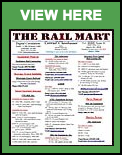Recycling rail flatcars for use as bridges
How much weight can a flatbed bridge handle
Flatcar bridges should be able to handle approx. 50 tons (140,000 lbs).
How to determine the approx. weight of a railroad flatcar bridge
- Flatcars will be marked with a lightweight on them. That includes the weight of the truck sets, couplers etc. that will be removed. These items weight approx. 20,000 LBS for a 70 ton car and 22,000 lbs. for a 100 ton car.
A typical 89′ flatbed with the trucks and equipment removed will weigh approx. 40,000 to 42,000 lbs.
These numbers can be adjusted for flatcars of different lengths. The trucks & other equipment remain the same.
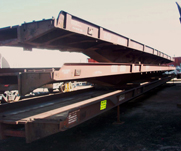
Flatbed railcars with the trucks, couplers, brakes removed in preparation to be used as a bridge.
Typical length & width of railroad flatcars for use as bridges
Flatcar lengths run from: 45′ to 89′-4″
Flatcar widths run from 10-‘6″ down to 8’
Typically the 60′ and under flatcars can be wider. They range from approx. 9′ to 10′ wide
The 89′ flatcars are are typically 9′ wide
The most common sizes are 45′, 60′ and 89′. The 45′ are 89′ cut in half.
![]()
Other details on rail flatcar structure
Flatcars have a center plate approx 11’6 in from each end. These are the points that the flatcars are mounted on the trucks.
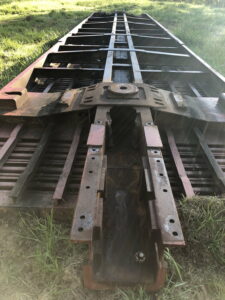
Centerplate support structure on ends of flatbed
The link below is a study done by Iowa state government on the use of railroad flatcar bridges as a low cost alternative for low traffic volume bridges. It gives a complete evaluation of the cost and structure stability and much more technical information.
http://publications.iowa.gov/11691/1/tr421.pdf
Notes:
Railroad Flatcars can be cut in half and joined to double the width of the flatcar bridge
as well as joining two matching flatcars side by side.
Structural center plates are located approx. 10′ from the ends.
(Although you can put supports closer or further away from the center plates)
Double Wide bridges
Often time you can double the width to 18′ by cutting an 89′ railroad flat car or other flatbed car in half and butting or attaching them together
as well as joining two similar bridges of an length.
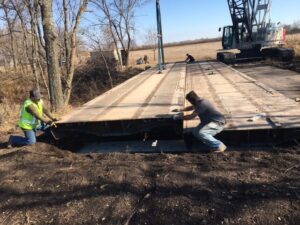
89′ flatcar cut in half to make a double wide bridge.
Flatcar bridges used on farms for over creeks
Railroad Flatcars are often just placed over creeks on a bed of gravel. This method is often used on farms and can be used in parks for foot traffic. This can provide an inexpensive access and save a lot of time and money. Tractors and other farm equipment can easily move over without problems. They can be moved when needed.
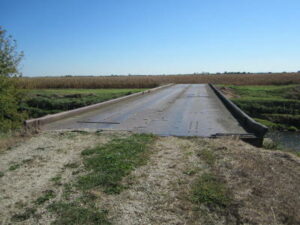
Farm bridge made from railcar flatbed.
Is it economical to use a rail flatcar to build a bridge What it the cost?
From the studies I have seen and the data provided me on some of the links I have shared it looks like using a flatcar for a bridge will save you about 50% for finished bridges and 80% when used as basic farm crossing with minimum structure. Of course the price will change depending on the length and width of the bridge as well as transportation cost and what type of use and finish it will need. Anything from a single wide for pedestrian crossing to double wide for low volume traffic to a wildlife crossing. Cost can vary month to month following scrap prices and availability will vary. Railcar scrappers consider the weight, storage cost and holding cost that are all added into the calculations. Additionally cost can be effected by transportation as well as crane rental and different local laws. Below is a link if you want to get a price quote and more information.
Flatcar for bridge cost price quote.
Youtube video I found with some helpful information in it.
Railroad Classification:
Class “F” – Types of railroad Flatcars
This type flatcar is typically used for flatcar bridges
FM – Ordinary flatcar for general service. This car has flooring laid over sills and without sides or ends.
Below – flatcars types are not recommended for making a flatcar bridge or require additional work to be suitable.
FA – Flatcar specifically equipped with superstructure or containers for transporting set-up vehicles, not suitable for miscellaneous commodities.
FB – Bulkhead flatcars. Equipped with fixed or permanently attached movable bulkheads or ends a minimum of three feet in height and flat floor for general commodity loading.
FBC – Flatcar constructed with a center beam above the car deck from bulkhead to bulkhead.
FC – Flatcars specifically equipped to carry trucks, trailers, containers, chassis, or removable trailer bodies for the transportation of freight in
TOFC/COFC service.
FCA – Flatcar, articulated multi-unit, specially equipped to carry trailers, containers, chassis, or removable trailer bodies for the transportation of freight in TOFC/COFC service.
FD – Depressed-center flatcar of special construction having the portion of the floor extending between trucks depressed to provide necessary head room for certain commodities.
FL – Flat logging car or logging truck. This is either a straight-deck flat car, with or without bulkheads or load restraining devices, or car consisting of two trucks fitted with cross supports over truck bolsters; the trucks connected by a skeleton or flexible frame and logs loaded lengthwise on cross supports.
FW – Flatcar with hole to enable lading to be lowered due to clearance limits.
Disclaimer:
The content provided are approximate numbers and not to be considered accurate. We try to provide the most accurate information we can but it is just some general guidelines. The Rail Mart is not responsible for any of the information provided. Check local building codes and consult an expert before starting any project.

